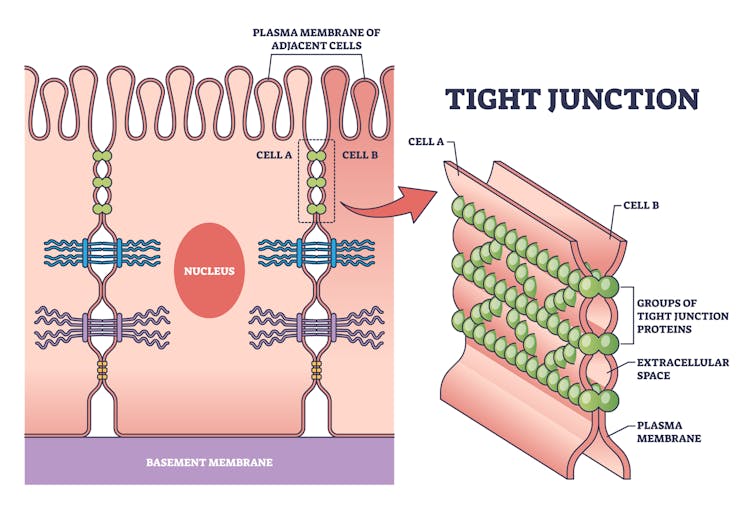You’ve likely heard about vitamin D’s important role in maintaining strong bones and teeth. But it also plays several other important roles to keep your body healthy – including the function of your gut.
As part of our research on how a dietary fiber supplement affects bone mass in children and adolescents, the MetA-Bone Trial, we are also studying gut health.
For this study, we recruited 213 children and adolescents from South Florida, primarily Hispanics, though some were Black. Before having them start taking the fiber supplement, we measured their vitamin D levels to ensure they had adequate amounts. Surprisingly, we found that 68% of these children had suboptimal vitamin D levels.
Considering South Florida is an area with plenty of sunshine year-round, this was both startling and concerning. While vitamin D can be obtained from foods, most people in the U.S. get this vitamin primarily from skin exposure to sunlight. For youth approaching or experiencing puberty – a period of profound physiological changes, including rapid changes in bone mass – vitamin D deficiency could lead to several health issues.
Hrant Khachatryan/Unsplash, CC BY-SA
Connection between vitamin D and health
Vitamin D is involved in so many bodily functions because there are vitamin D receptors in different organs. These receptors act like docking stations for vitamin D to bind to and trigger different effects in the skin, intestine, bone, parathyroid gland, immune system and pancreas, among others.
Vitamin D regulates calcium levels in the body, which is key for not only building and maintaining bone mass but also the basic functioning of the nervous system.
Vitamin D also stimulates cell differentiation, a process in which cells become specialized to carry out specific functions. It is also essential to insulin secretion to control blood sugar levels, blood pressure regulation, muscle repair and regeneration, immune function and nutrient absorption, among many other functions.
Vitamin D and gut health
The vitamin D receptors in your gut improve calcium absorption and strengthen your intestinal barrier.
The intestinal barrier is a layered wall that allows your gut to absorb nutrients and keep out harmful bacteria. This wall is composed of intestinal cells and proteins called tight junctions that act like bricks sealing these cells together. Tight junctions play an important role in maintaining the structure of your intestinal barrier.

VectorMine/iStock via Getty Images Plus
Vitamin D receptors help your gut produce tight junctions to maintain your intestinal barrier. Research suggests that vitamin D deficiency reduces production of the receptors the nutrient binds to, subsequently reducing the seal of the intestinal wall. This weakening of the gut barrier may allow substances from the intestine to pass into the blood, causing inflammation. Disruption of the intestinal barrier is linked to many diseases, including liver disease, Type 1 diabetes, obesity and gastrointestinal conditions such as celiac disease, inflammatory bowel disease and colon cancer.
After discovering that so many of the participants in our MetA-Bone Trial had suboptimal vitamin D levels, we became interested in understanding how this nutrient might be affecting their gut health. For this, we also measured the strength of their intestinal barrier and associated this to their vitamin D levels in blood.
We found that children with suboptimal vitamin D levels had a higher risk of damaging their intestinal barrier compared with children with optimal vitamin D levels. This finding suggests that even in healthy children, suboptimal levels of vitamin D may compromise the gut and potentially increase the risk of developing chronic diseases at an early age.
Getting enough vitamin D
Vitamin D deficiency is highly prevalent in the U.S. and around the world. Roughly 15.4% of children and adolescents in the U.S. were vitamin D deficient in 2017. While vitamin D deficiency has slightly decreased over time in the general U.S. population, it remains high among teens, especially children with darker skin.
How can you ensure you are getting enough of this important nutrient?
Only a few foods naturally contain vitamin D. For example, vitamin D is naturally found in fatty fish – such as trout, salmon, cod and tuna – egg yolks and mushrooms. Vitamin D can also be found in many fortified foods, such as dairy products like milk and cheese, plant-based milks, breakfast cereals, some orange juice brands and infant formulas. Dietary supplements are also good sources of vitamin D.

happy_lark/iStock via Getty Images Plus
For most people in the U.S., Sun exposure is their main source of vitamin D. However, how much Sun exposure you need depends on several factors, such as the melanin content of your skin. Melanin is a pigment that protects your skin from ultraviolet radiation. People with more melanin – and therefore darker skin – produce less vitamin D from Sun exposure than those with less melanin and may thus require longer Sun exposure to meet minimum requirements.
Since excessive ultraviolet radiation is associated with skin cancer, clinicians typically recommend you meet your vitamin D requirements through foods and beverages. For healthy children and adults, the recommended dietary allowance of vitamin D is 600 IU, with an age-based upper limit of no more than 1,000 to 4,000 IU. You can usually meet this through a healthy diet that includes a variety of whole and unprocessed foods.
Researchers continue to uncover the extensive benefits of vitamin D in the body, supporting its indispensable role in nutrition and health. For growing children and adolescents, enough vitamin D is important for healthy development.




